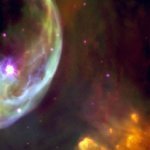-
Posts
4 -
Joined
-
Last visited
Content Type
Profiles
Forums
Events
Posts posted by Domobran7
-
-
20 hours ago, Genady said:
I don't think so. The galaxy rotates because of the collapse of an original cloud into the flattened disk and conservation of angular momentum. No such collapse occurs with DM halo.
x with swansont
But considering that one of reasons why galaxy rotates is the black hole at its center (and black holes formed naturally all seem to rotate, as far as I'm aware), and the dark matter is somewhat responsive to gravity, wouldn't that incite dark matter halo to at least somewhat flatten and rotate? Or the effect is simply too weak?
0 -
1 hour ago, Phi for All said:
Touch needs to be divided into more parts, imo. With touch we know when we make contact with an object, whether it's soft or hard or sharp or wet (textures) or hot or cold (temperature) or vibrating. We associate pain with touch receptors as well, and even emotions like compassion can be detected and even delivered through touch, so I think these are all separate senses, or deserve to be.
All of these are merely different functions of touch, because ultimately all of these use the same receptors. Just like sight relies on eyes only, but you can see colour, size, shape, distance, motions, velocity and so on.
1 hour ago, Phi for All said:And where does proprioception fit in? It's the sense that lets us know where we are in relation to the space around us, so we don't have to watch each stair as we climb them, or so we can touch our nose with our fingertip when our eyes are closed.
We also have a sense of balance that seems caught up with tubes in our ears, but has nothing to do with hearing.
I do not think it fits in a sense as in "something that allows us to sense the world around us". Rather it would be a system that allows us to actually utilize input from our senses.
1 hour ago, Phi for All said:I've heard some claim we have a sense of proximity, like how close we're standing to a wall, but I think that's a combination of feeling air pressure against the skin and hearing the difference sound makes when it's being reflected off a close surface.
Precisely.
1 hour ago, Phi for All said:And of course, there's the fact that we don't sense anything with our receptors directly. It's all filtered and interpreted by the brain, which is so fast that it often predicts what you're supposed to be seeing based on past experiences before the light actually reaches your eyes.
Well, reality really is an illusion created by our brain. But things that illusion is based on are real enough.
0 -
48 minutes ago, vitttorrio said:
Hello! The most of the living population of our planet can observe light and colors, right? But what was light before there was life in the universe? How can we look on the earlier universe when you couldnt feel, look or hear anything. Is it just like it was waiting till life would be created, or is it more complex than that and like the infinity just inconceivable for us?
Not sure if I understand what you are asking but... we evolved senses to make use of the inputs in our surroundings. Human senses are sight, hearing, touch, taste and smell. All of this is based on inputs - light, sound, matter - that had existed long before there were any humans, or indeed any life. Light was there, there just wasn't anybody to observe it.
And this has implications for science.
Light has a finite speed (cca 300 000 km/s). This means that watching the world around us is already a type of time travel - even if it is a fraction of a second, we never actually see things at the exact moment they are happening at. And at interstellar distances, this delay is significant.
What this means is that light is essentially a "message in a bottle" from our past. If we watch at a galaxy that is a billion light years away, we see it as it was a billion years ago. And from that, we can extrapolate what our own galaxy was like a billion years ago.
One of these answers is probably to a question you hadn't asked, but...
0



dark matter question
in Astronomy and Cosmology
Posted
Looking at it now, it seems that the effects of the black hole are too localized to really matter. Still, if black hole had no influence at all, why are there so many spiral/disc/etc. shaped galaxies? I always assumed it had to do with influence of the black hole, but could it be the natural result of galaxy's rotation? And if so, would that mean that original galaxies were all roughly spherical, similar to the dark matter halo? But if it is the case, why is the Large Magellanic Cloud an irregularly shaped galaxy? Could it have been a small spiral galaxy that got distorted by the Milky Way, or there is a lower mass limit on spiral / disc galaxies?